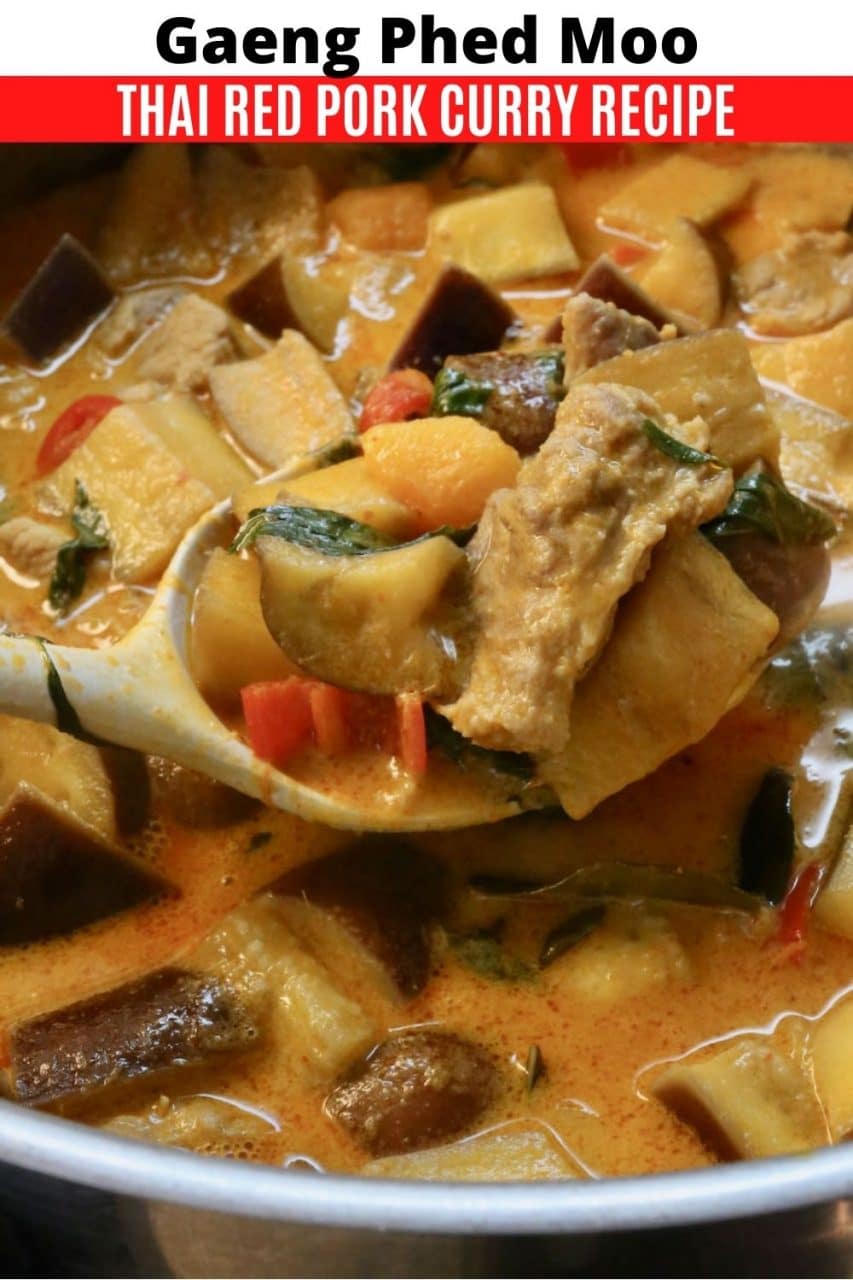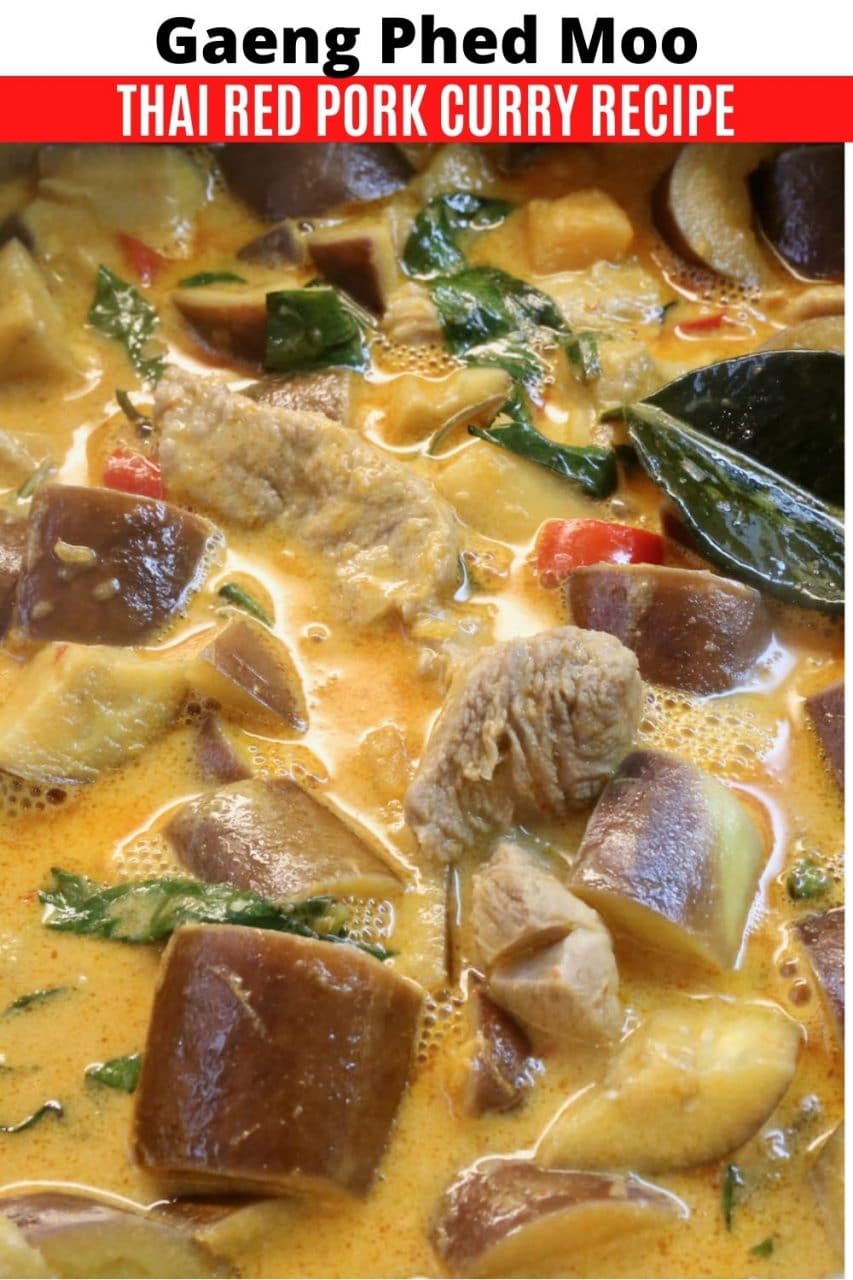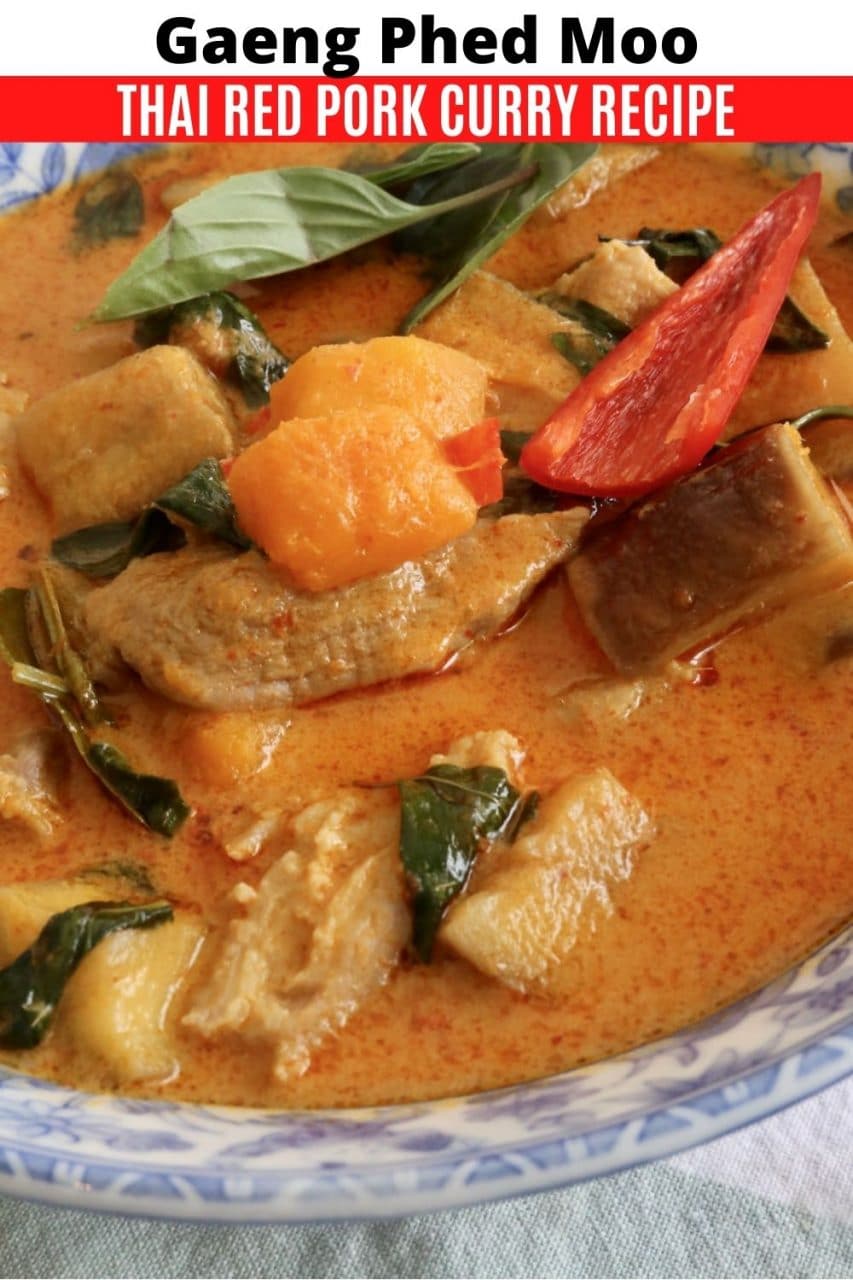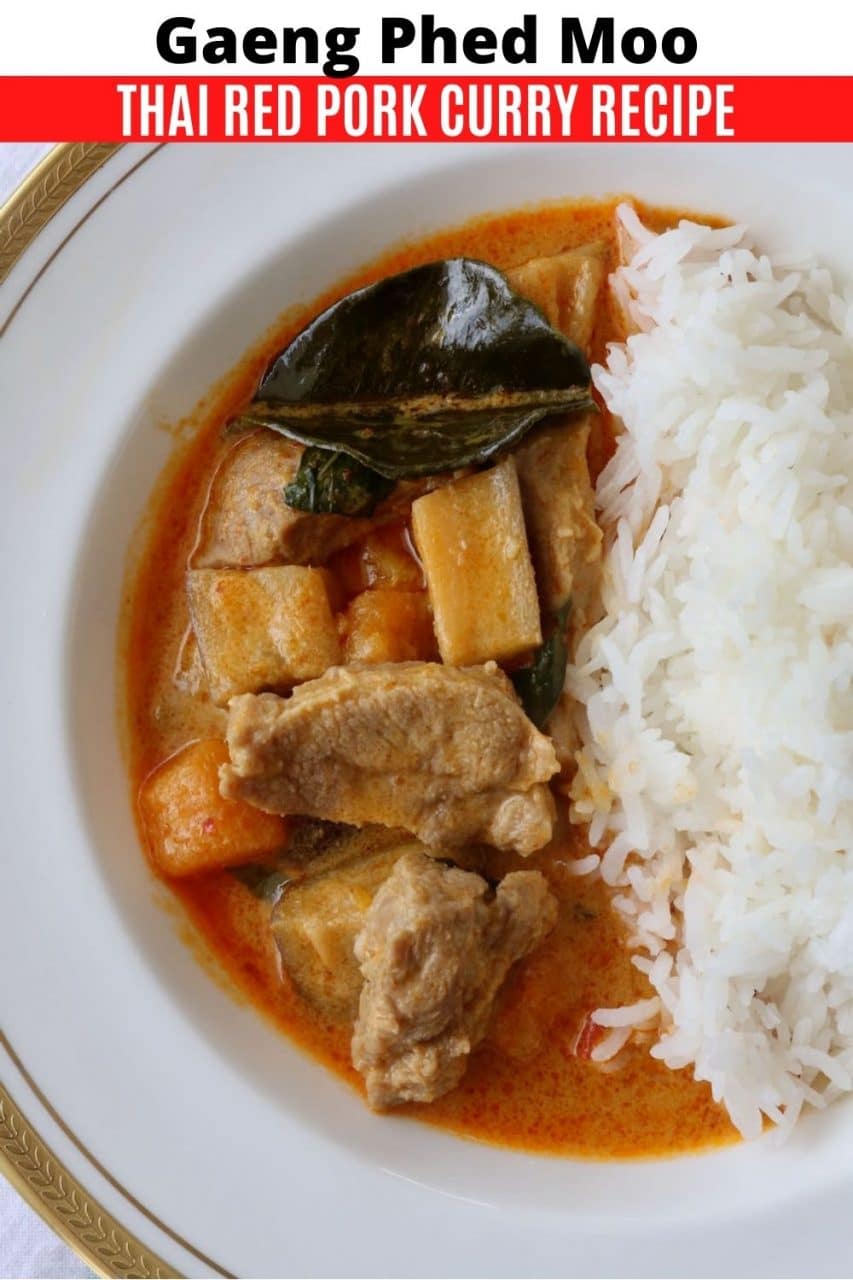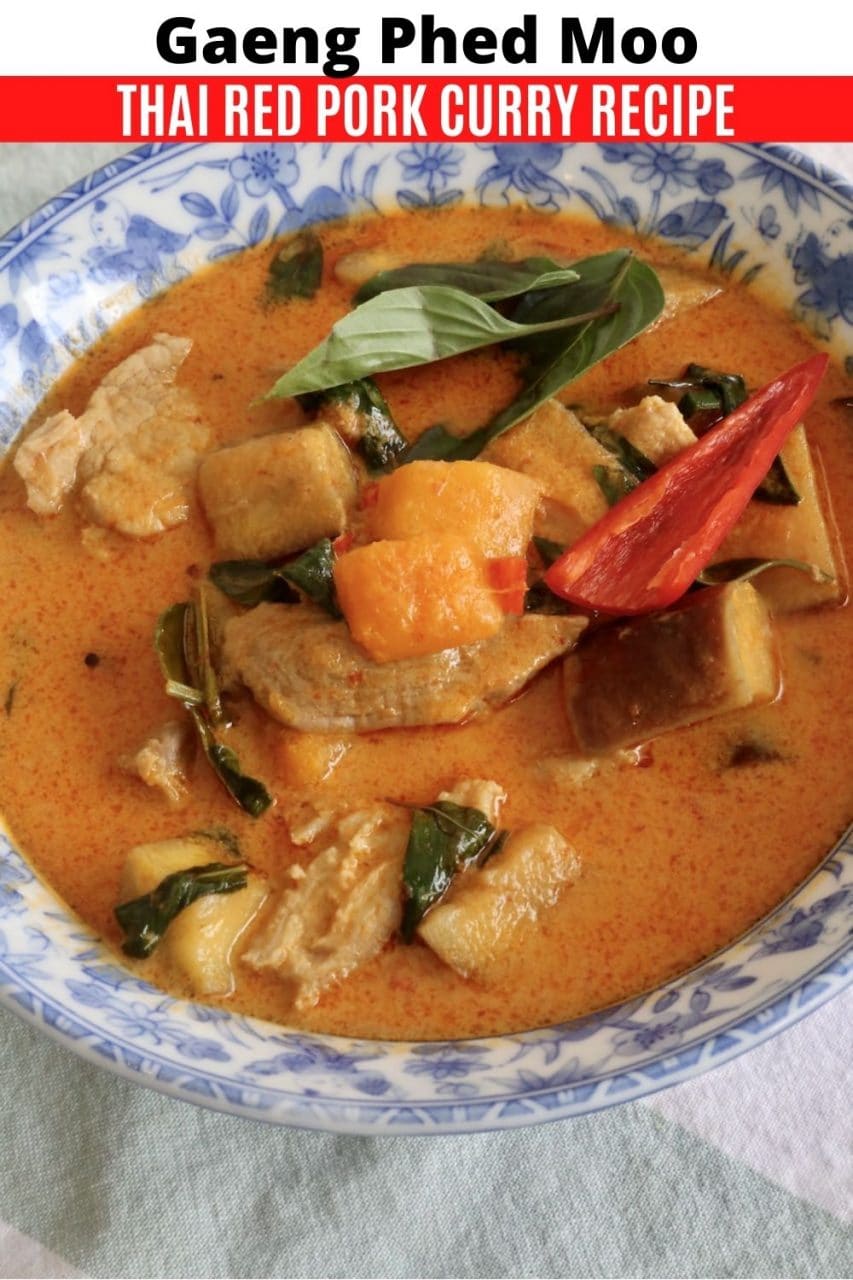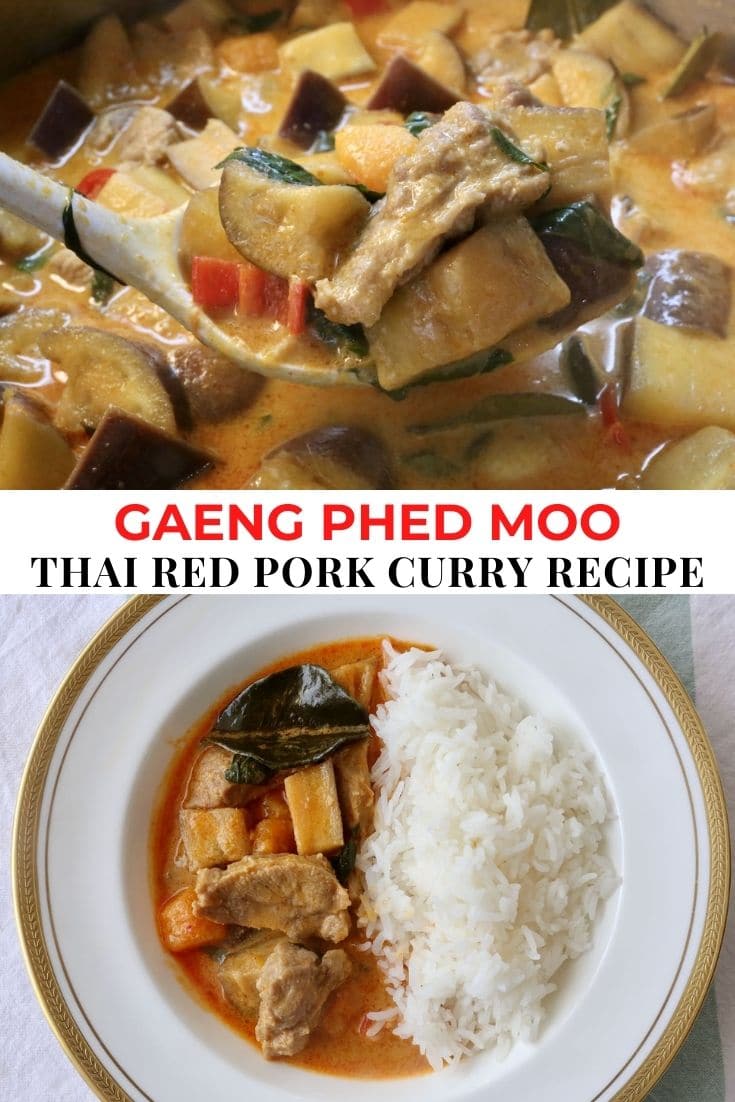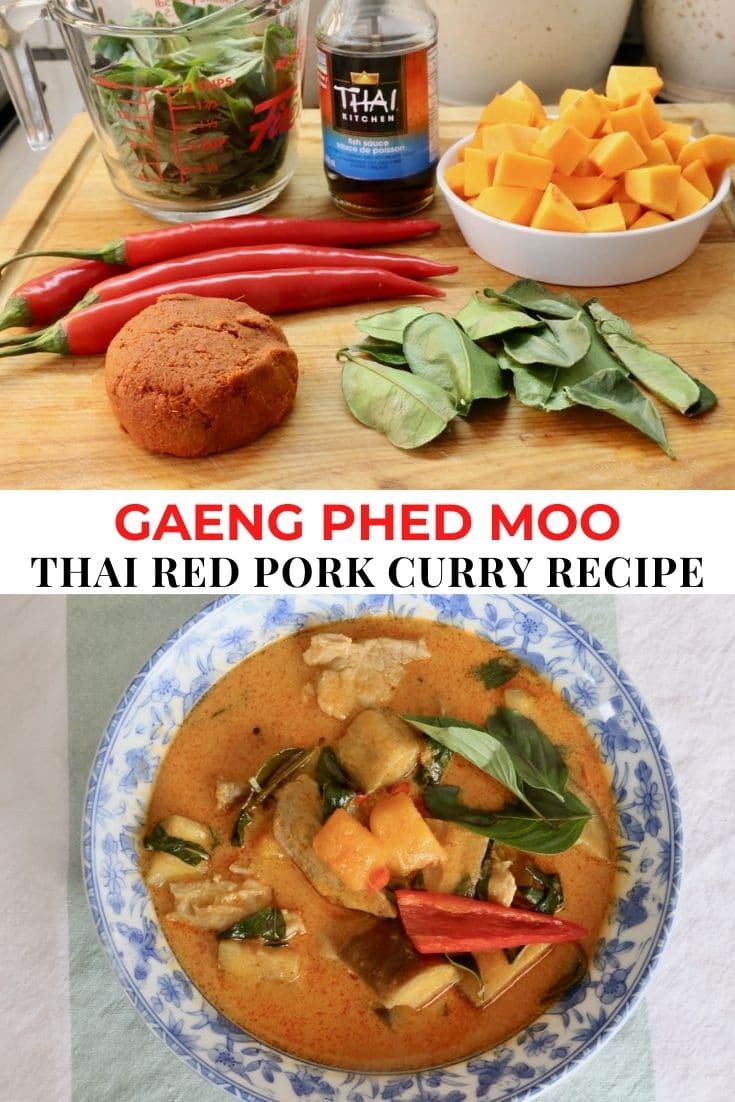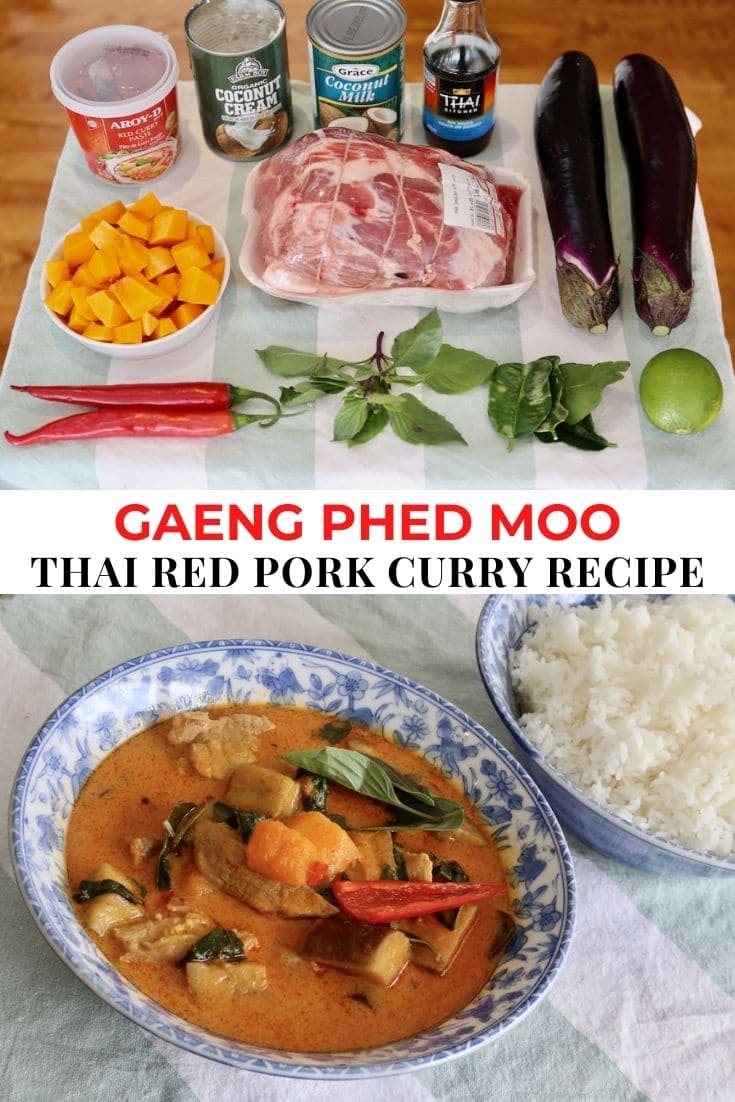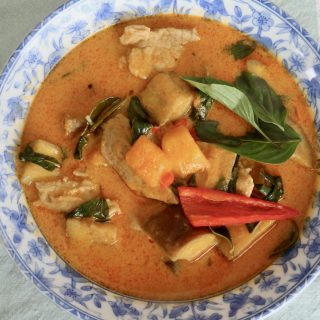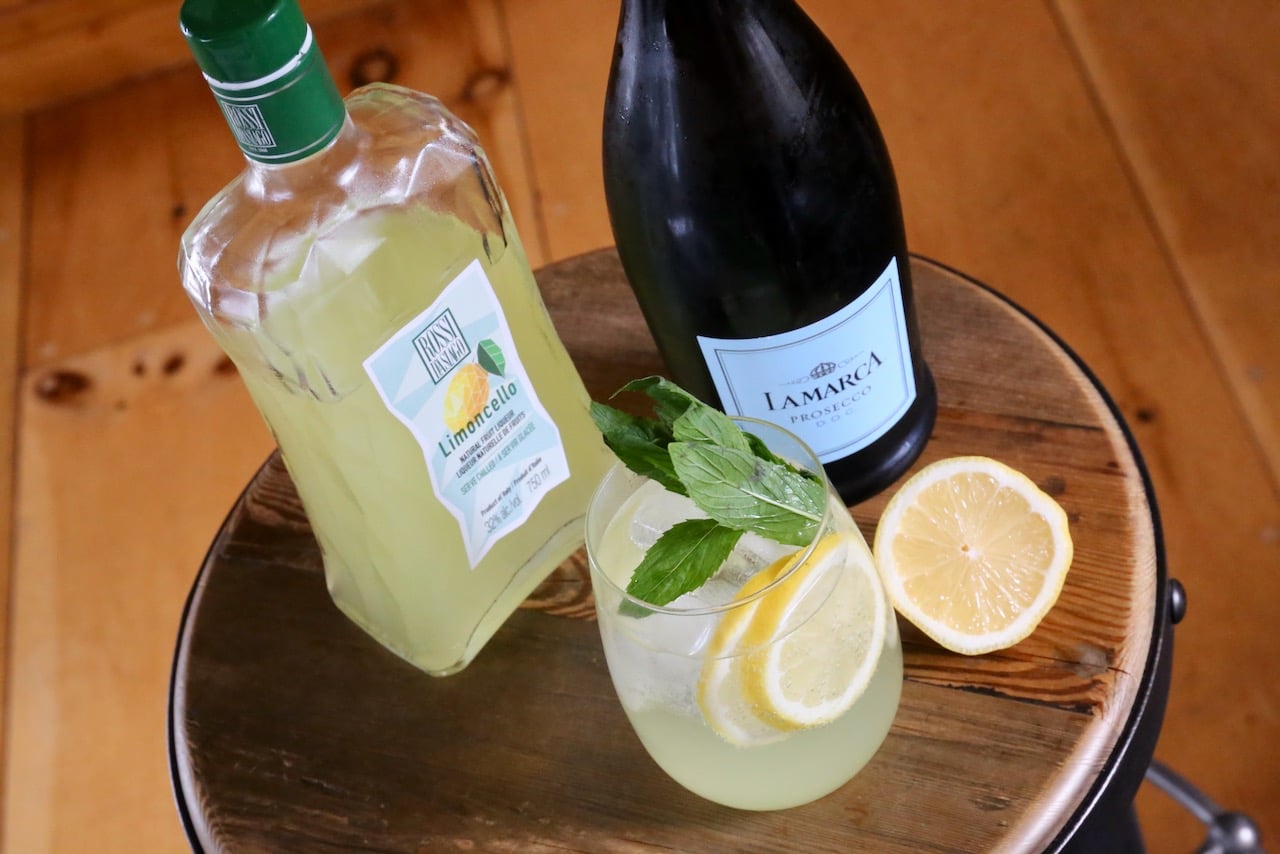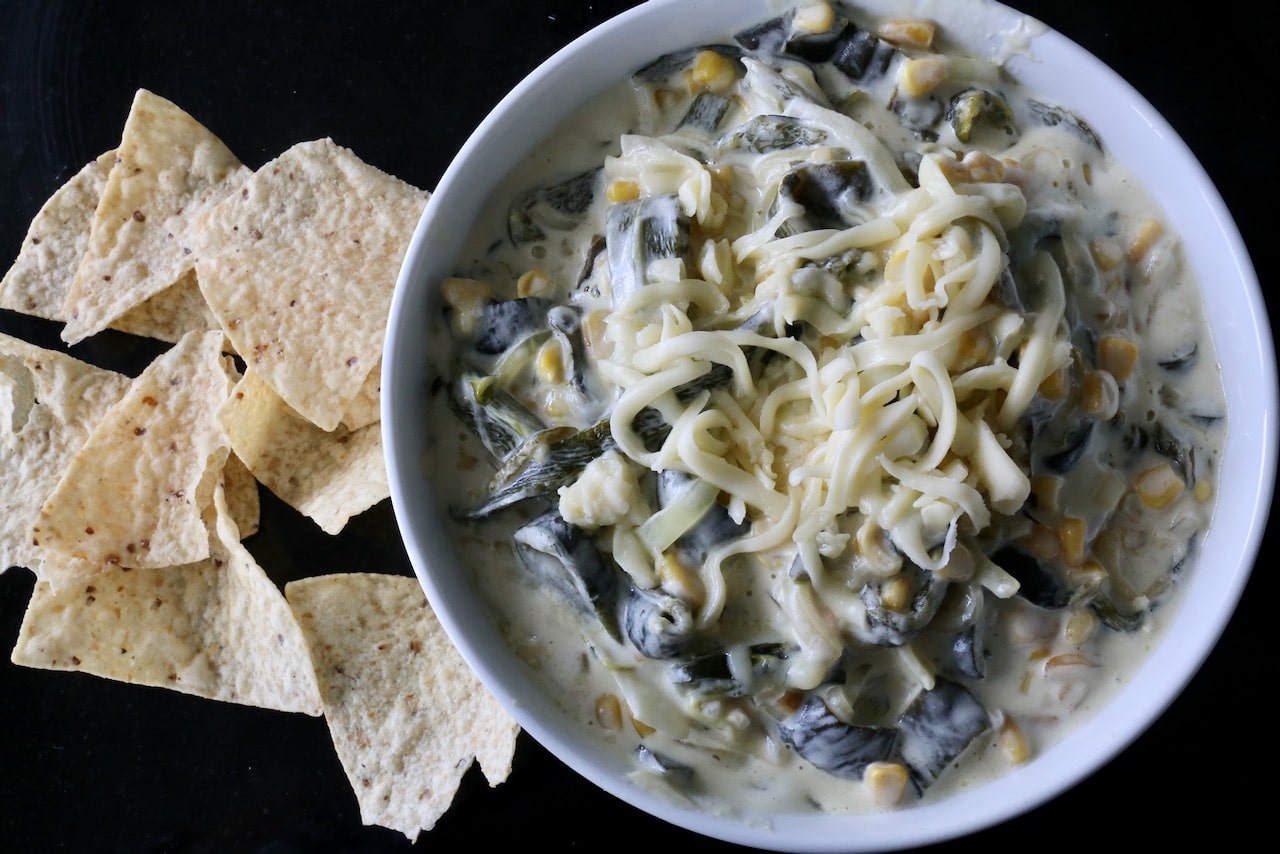Red Thai Pork Curry is our favourite creamy coconut stew from Thailand to cook at home.
Thai Pork Curry, also known as Red Curry Pork or Gaeng Phed Moo, is a traditional creamy coconut stew from Northern Thailand. The decadent dish is typically served in restaurants as a main course or entree.
Traditional recipes feature ingredients like pork shoulder, eggplant, coconut cream, red curry paste, palm sugar, squash or pumpkin, spicy chilies, Thai basil leaves, lime leaves and fish sauce.
We’ve traveled extensively through Thailand and eaten at all of the best Thai restaurants in Toronto. We’ve taken Thai cooking classes in Chang Mai and learned expert cooking techniques courtesy of the executive chef at JW Marriott Phuket Resort.
Cooking Thai food at home is quick and easy. We suggest doubling the recipe as we know you’ll love loitering over these delicious Red Thai Pork Curry leftovers!
Save this story to Pinterest!
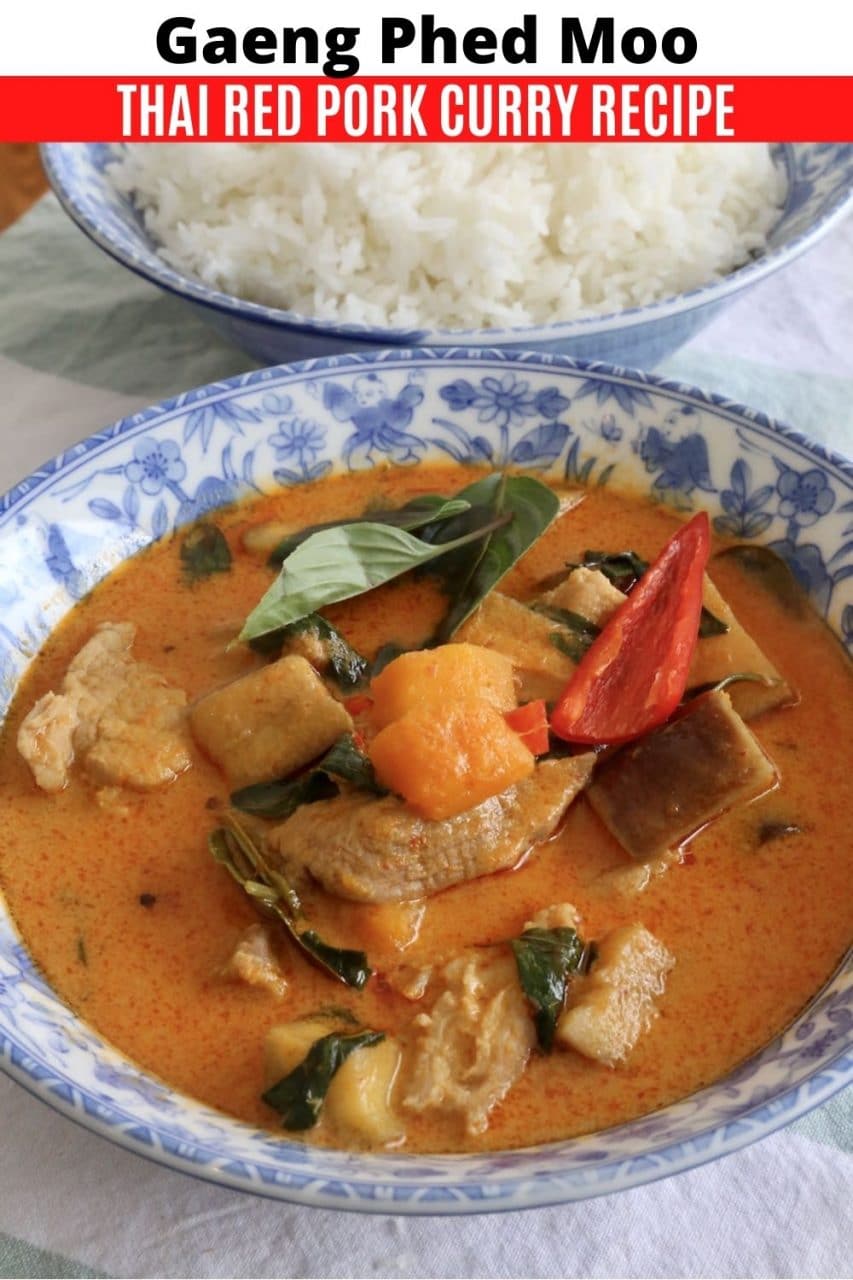
Travel to Asia by Cooking Thai Pork Curry at Home
I love traveling through Asia.
My first visit had me living in South Korea for a year as a teacher and it’s where I was first introduced to fermented vegetables like kimchi.
After my contract ended in Seoul I travelled throughout southeast Asia for 6 months, visiting the Philippines, Indonesia, Malaysia, Singapore, Cambodia, Myanmar, Thailand, Vietnam and Laos.
On my first visit I spent over a month backpacking through Thailand. I’ve revisited Thailand two times since as a food and travel journalist and always love to discover new regional dishes. Over the years I’ve explored Thai destinations such as Ko Phi Phi, Krabi, Chiang Khong, Chang Mai, Sukothai and Bangkok.
What I found most fascinating is Thailand’s distinct regional food cultures. Much like the regional cuisines found in Germany, Italy or Spain, each town in Thailand had its own local speciality.
Gaeng Phed Moo is a dish most commonly cooked in Northern Thailand. The recipe features vegetables that easily grow in the mountainous jungle region like squash and eggplant. Pork is also more prevalent in the north, whereas you’d find more curries featuring seafood in Southern Thailand where beautiful beaches are the big draw.
You May Also Enjoy Reading…
- Things to Do When Beach Hopping in Thailand
- Phulay Bay Ritz-Carlton Reserve in Krabi
- Amari Vogue Krabi Luxury Resort in Thailand
- Four Seasons Resort Koh Samui
- The Tongsai Bay Luxury Resort in Koh Samui
- W Koh Samui Luxury Resort in Thailand
- Amari Resort Koh Samui in Thailand
- Amari Phuket Luxury Resort in Thailand
- 10 Must Try Tastes in Thailand
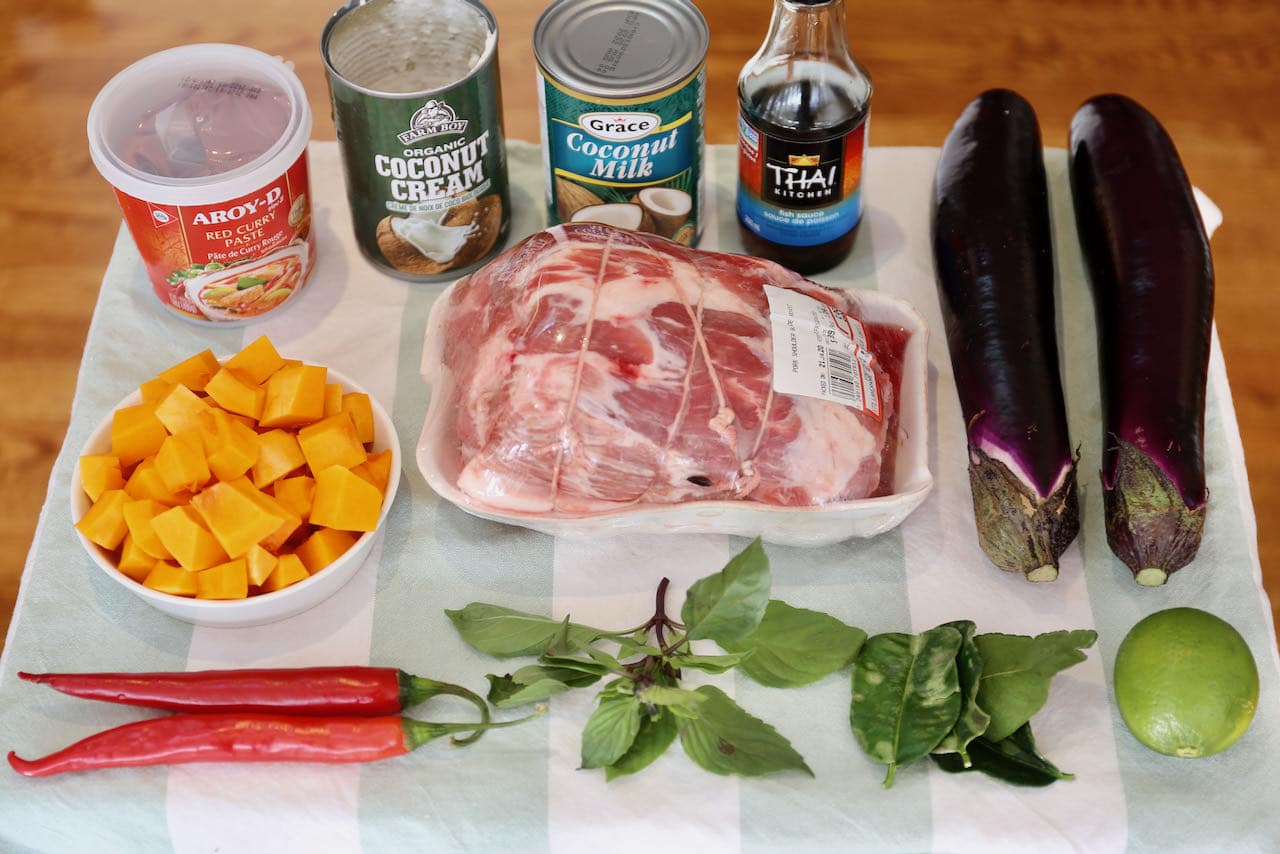
Where To Eat Red Thai Pork Curry
If you live in a large city in Canada or America you’ll likely have access to a local Thai restaurant that serves traditional Thai Red Curry Pork.
Haven’t traveled to Thailand before? It may be helpful to first sample Red Curry Pork at a local Thai restaurant to better understand how the dish is served. You can also assess what vegetables the chef added to the stew, ideal coconut milk to pork ratio and get ideas on other Thai dishes to serve alongside the popular entree.
I spent months researching the best Thai restaurants in Toronto, visiting popular restaurants that serve authentic Thai dishes such as Sabai Sabai, Sukothai, Khao San Road, Pai, Kiin, Bangkok Garden, Mengrai Thai and Favorites Thai BBQ. If you’re looking to sample authentic Thai Pork Curry in Toronto try visiting one of these award-winning restaurants.
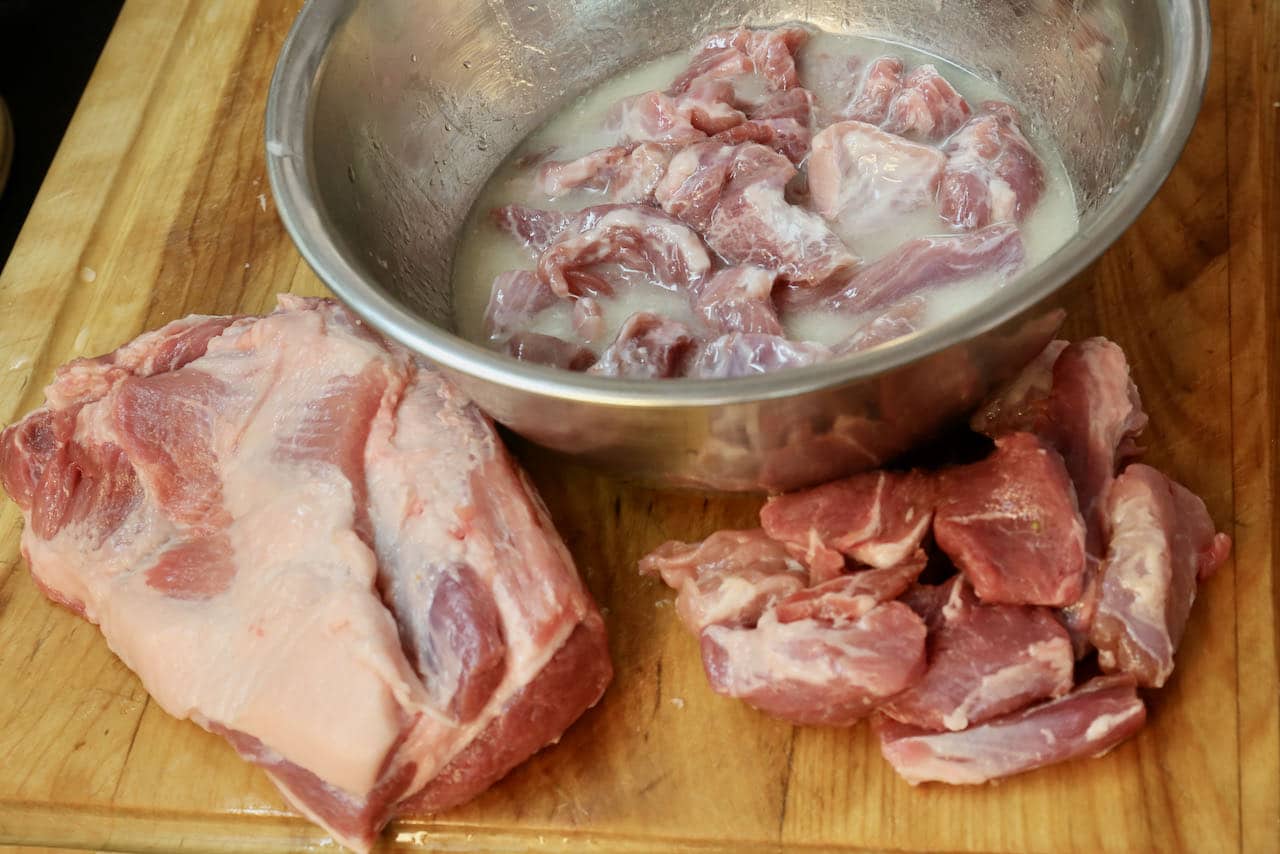
Best Pork Cut For Gaeng Phed Moo
Traditional Thai Pork Curry is prepared with the fatty pork shoulder cut, also known as pork butt.
Pork shoulder is a relatively tough and inexpensive cut of meat layered with fat that comes from the pig’s shoulder region. You may also see this cut labeled as pork butt or Boston butt, but don’t get confused by the misleading names as the meat always comes from the shoulder region.
The actual rear of the pig is called the ham. Pork shoulder is sold bone-in or boneless, and typically weighs between 5-10 pounds.
Pork shoulder might start out as a fatty, tough cut of meat, but braise it in liquid and it transforms into tender, juicy shreds that fall apart with ease.
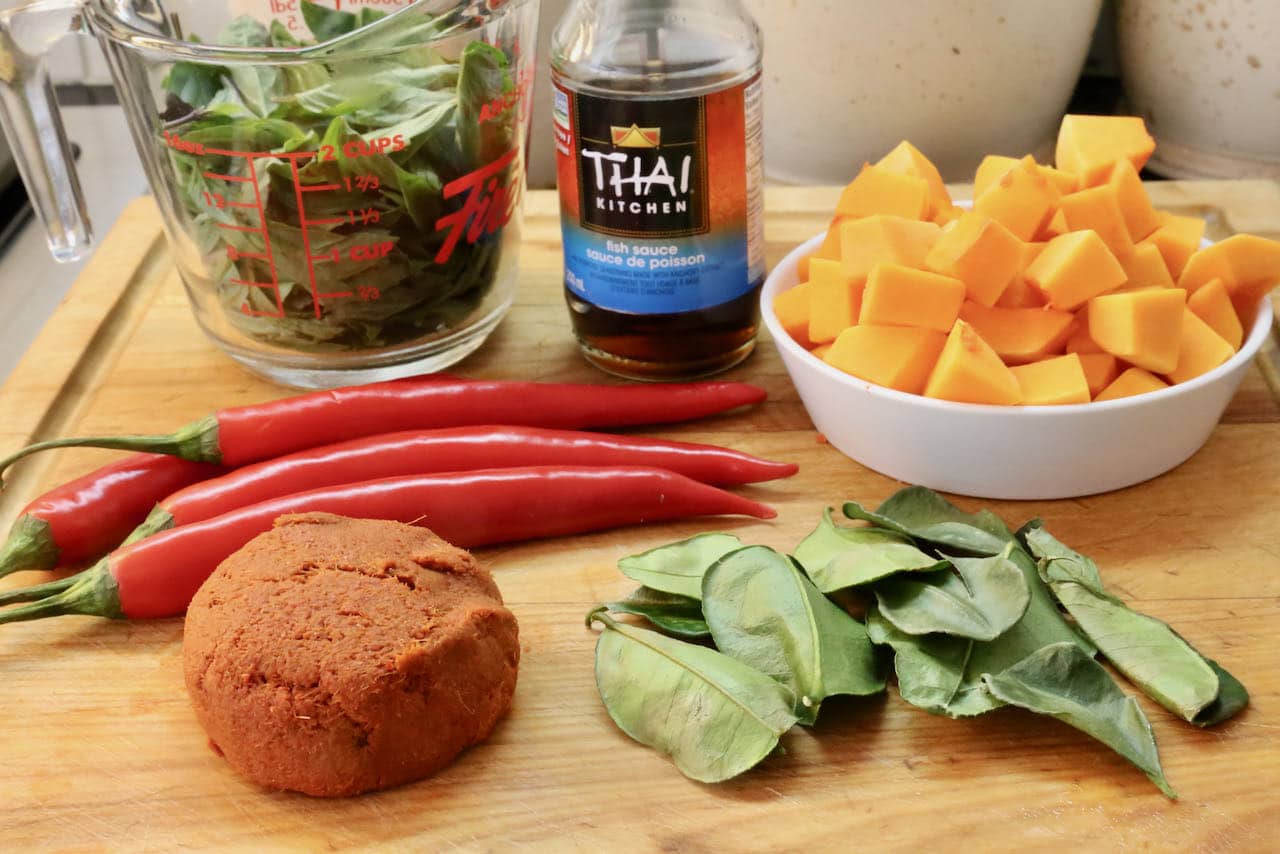
Health Benefits
Our Red Curry Pork recipe is packed full of healthy ingredients!
Pork is an excellent source of protein and provides several important vitamins and minerals. It’s an excellent source of thiamin, selenium, niacin, vitamin B-6 and phosphorus, zinc, riboflavin and potassium.
All varieties of pumpkin (or squash) are nutritious, but butternut squash is a superfood because it contains high levels of carotenoids, which help combat cancer and support skin health.
Eggplants are a nutrient dense food that contain a good amount of vitamins, minerals and fibre in few calories. It’s a good source of manganese, folate, potassium, vitamin K and C.
Coconut is rich in fibre and may also offer a number of benefits including improved heart healthy and digestion. It is high in calories and sautéed fat so be sure to eat in moderation.
A rich source of phytochemicals and vitamin C, limes help boost your immune system and neutralize free radicals that cause disease and skin aging. Lemons also protect against heart disease and help improve blood flow to the brain.
Chili has been proven to help reduce the duration of sickness, prevent heart disease, and promote weight loss.
The eugenol in basil can block calcium channels, which may help to lower blood pressure. The essential oils in the herb can help to lower your cholesterol and triglycerides. Basil also contains magnesium, which can help to improve blood flow by allowing muscles and blood vessels to relax.
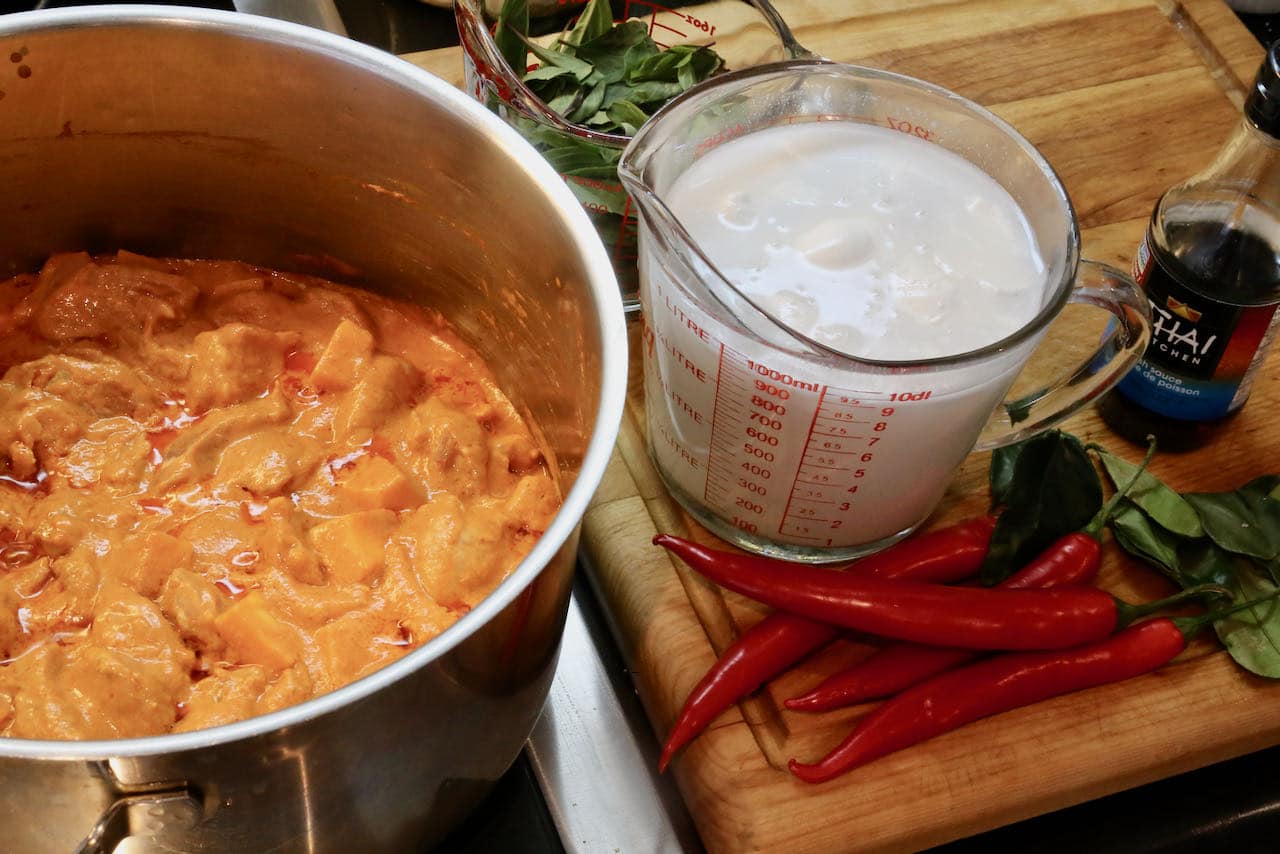
Types of Thai Curry
In Thailand, curry refers both to dishes in Thai cuisine that are made with various types of curry paste and to the pastes themselves. A wet Thai curry is made from curry paste, coconut milk, meat, seafood, vegetables and herbs.
You’ll find unique regional takes on the Thai curry concept in neighbouring countries such as Myanmar, Laos, Malaysia, Singapore, Indonesia, Cambodia and Vietnam.
Popular Thai curries include Green, Red, Yellow, Penang and Masaman. Most Thai curries are categorized by the colour of the curry paste. The colour of the chilies and other ingredients gives each curry its distinct hue. Traditionally, all Thai curries were made with the same ingredients except for one thing: the chilies. Usually green curry is the mildest, red is the hottest and yellow falls somewhere in between.
Masaman Curry uniquely influenced Thai cooking thanks to visiting Persian traders. Masaman is a broken translation for Muslim. It originated in the south of Thailand near the border of Malaysia and is a thick sauce with a mild, slightly sweet flavour. Massaman curry dishes distinguish themselves by the inclusion of several whole spices and peanuts.
Penang Curry is sweeter than its sister, spicy Thai Red Curry. It is named for the island of Penang off the west coast of Malaysia and is served sometimes topped with coconut cream.
Most Thai curry paste recipes are made with spicy chilies, garlic, ginger, galangal, lemongrass, shallot, fish sauce, shrimp paste, cane sugar, lime, spices and coconut milk.
We use Thai red curry paste when preparing this Thai Pork Curry recipe. You can prepare the homemade red curry paste or purchase prepared red curry paste online.
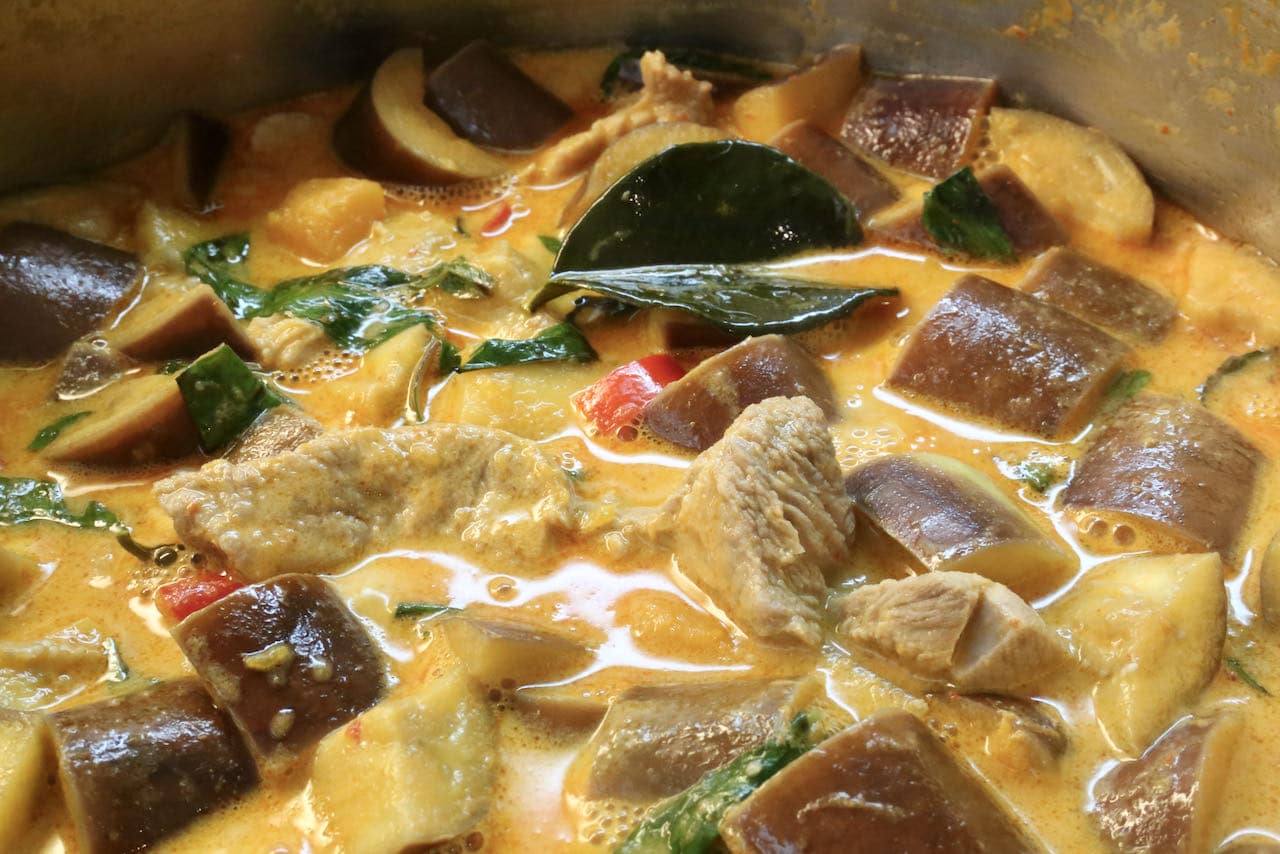
Homemade Thai Red Curry Paste
Feel free to use your favourite store bought Thai curry paste at the grocery store or prepare from scratch in your kitchen. Use a mortar and pestle to grind all the ingredients together until you’ve created a smooth and fragrant mixture. This homemade Thai red curry paste recipe yields 4-5 tablespoons.
- 1 tbsp coriander seeds, roasted until brown
- 2 cardamom pods, roasted until brown
- 1/2 tsp black peppercorns
- 1/2 tsp salt
- 10, large red dried chillies (seeds removed soaked in water for 10 minutes then finely chopped)
- 1 tsp galangal, skin removed and chopped
- 2 tsp lemongrass, chopped
- 1 tsp kaffir lime peel, chopped
- 1 tbsp coriander root, chopped
- 3 tbsp shallots, chopped
- 3 tbsp garlic, crushed
- 1 tsp shrimp paste
- 10, Thai red chillies
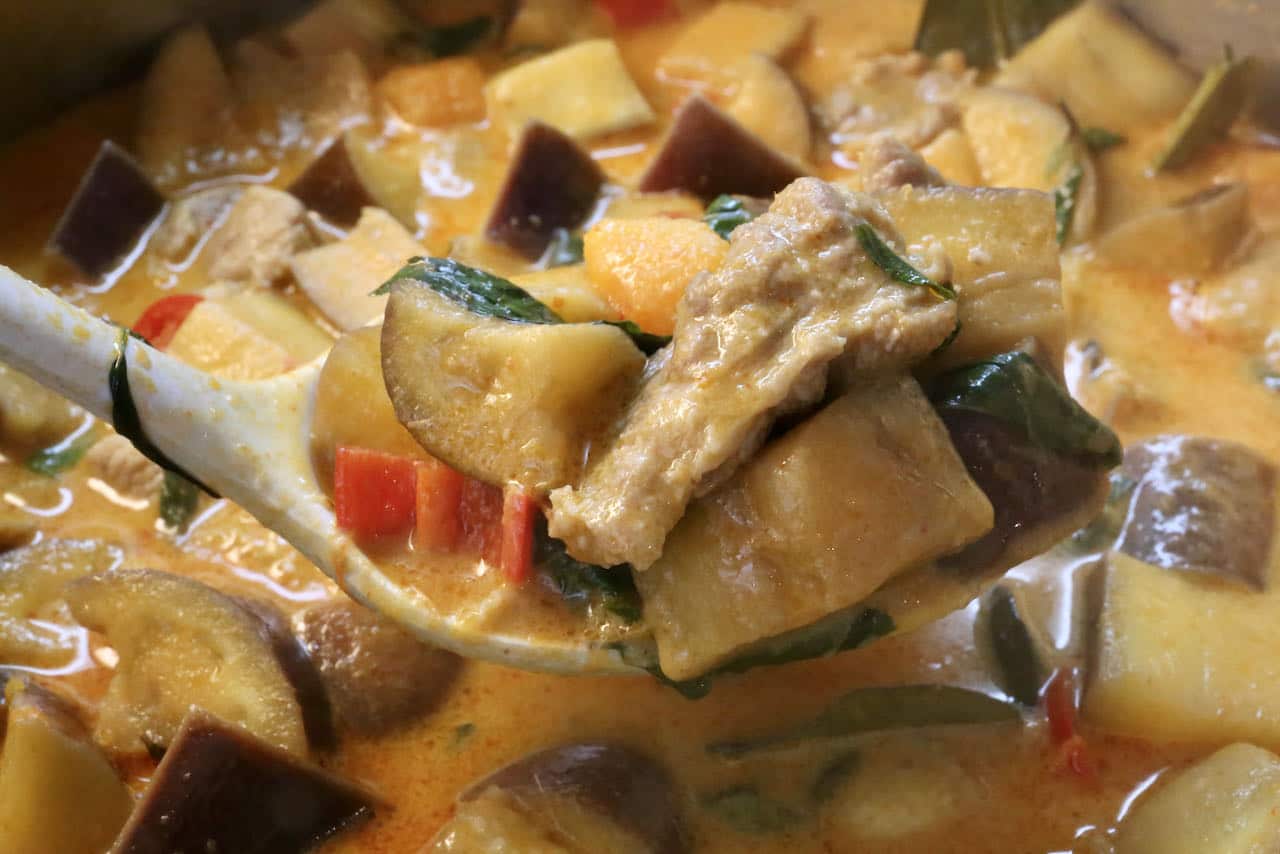
Cooking Tips
This yummy homemade Red Thai Pork Curry recipe is quick and easy to make at home.
- We suggest preparing Thai Red Curry Pork in a large wok to reduce splatter when cooking.
- We’ve used store bought Thai Red Curry Paste but you could also make Homemade Red Curry Paste.
- Purchase pork shoulder from your butcher and use a sharp knife to gently remove the meat from the bone and fat. Discard the fat and bone then slice the meat into strips. Use a digital scale to measure 1 kg of of the meat. Any leftover pork shoulder can be placed in a Ziplock bag and stored in the freezer to use later.
- We’ve used slender Japanese eggplants in this recipe but you could also use smaller Thai eggplants, Indian eggplants or Italian-style eggplants.
- We’ve used butternut squash in this recipe but you could substitute for buttercup, acorn, kabocha or delicata.
- Authentic Thai Pork Curry recipes are sweetened with palm sugar, which is available for purchase at Asian supermarkets. You can substitute for brown sugar.
- We suggest using fresh lime leaves but you could also substitute for dried lime leaf.
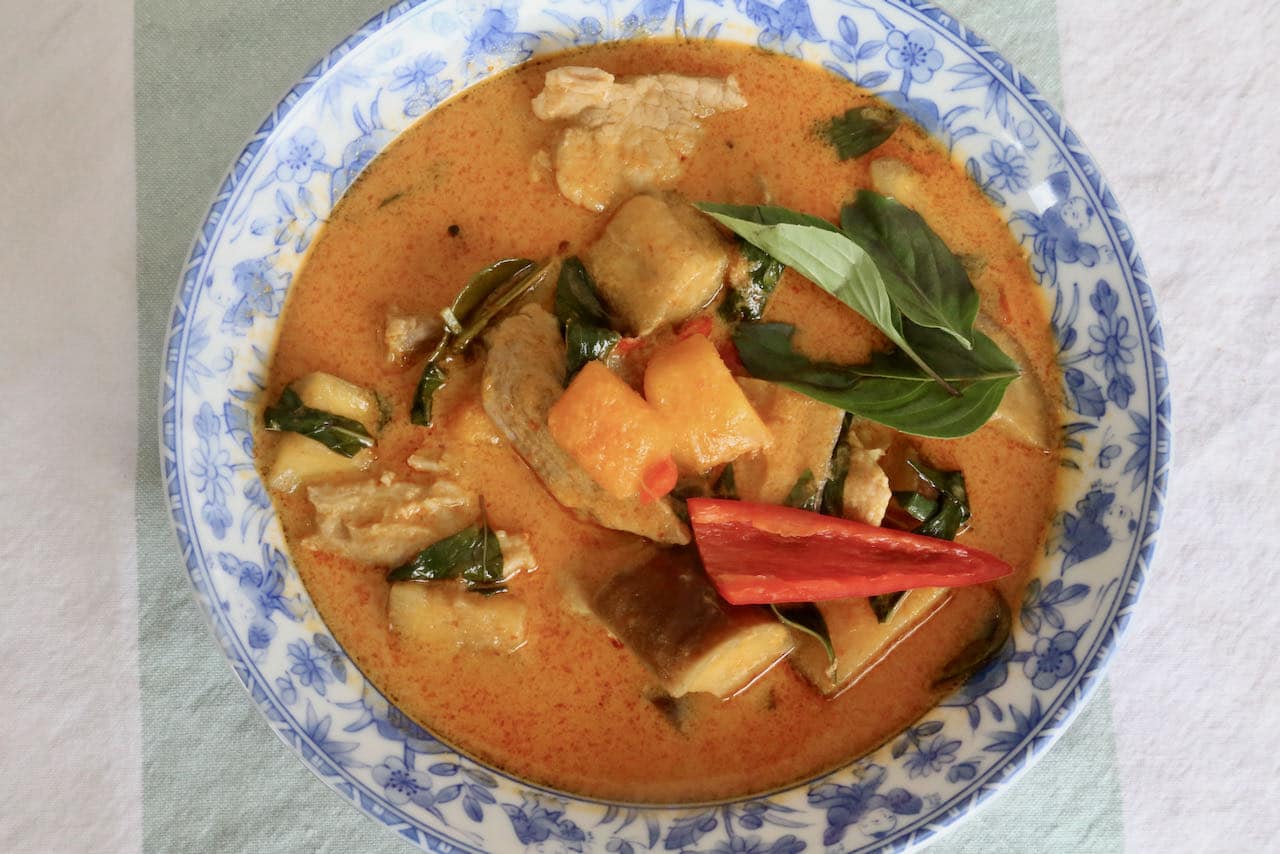
What To Serve with Thai Curry
Thai Pork Curry is typically enjoyed as a main dish, served alongside a bowl of steamed jasmine rice.
If you’re hosting a large Thai dinner party, we suggest serving homemade Pork Thai Curry buffet-style with other popular Thai dishes like Papaya Salad, Grabong Fritters, Beef and Pumpkin Curry, Red Prawn Curry, Pad Kra Pao, Thai Red Curry Prawn Burger, Thai Pork Rib Soup with Vermicelli Noodles, Egg Tofu Soup with Pork Meatballs, Gai Pad Med Mamuang Thai Cashew Chicken, Authentic Massaman Curry, Nam Tok Authentic Thai “Waterfall Beef” Salad, Thai Green Curry Chicken, Thai Pork & Beef Mince Curry Khua Kling, and Chiang Mai Noodles “Khao Soi.”
Creamy Thai Pork Curry keeps well in the fridge for 2-3 days so store it in an airtight container.

You May Also Enjoy These Pork Recipes…
- Southern Smoked Baked Beans with Bacon
- Fresh Fig Prosciutto Grilled Cheese Sandwich
- Cheesy Bacon Air Fryer Potato Skins
- Köttbullar med Gräddsås Swedish Meatballs
- Smokey BBQ Bone In Air Fryer Pork Ribs
- Cilantro Ginger Lime Cajun Shrimp Salad
- Seasoned Air Fryer Bone In Pork Chops
- Peynirli Pide Cheesy Chorizo Turkish Pizza
- German Pork Rouladen
- Portuguese Bean Soup Recipe with Kale and Sausage
- Romanian Soup Ciorba de Perisoare
- Spicy Szechuan Hot and Sour Soup
- Penang Prawn Noodle Soup Hokkien Mee
- Singaporean Bak Chor Mee Minced Pork Noodle Soup
- Chinese Wonton Egg Drop Soup
- Garlicky Sopa de Ajo
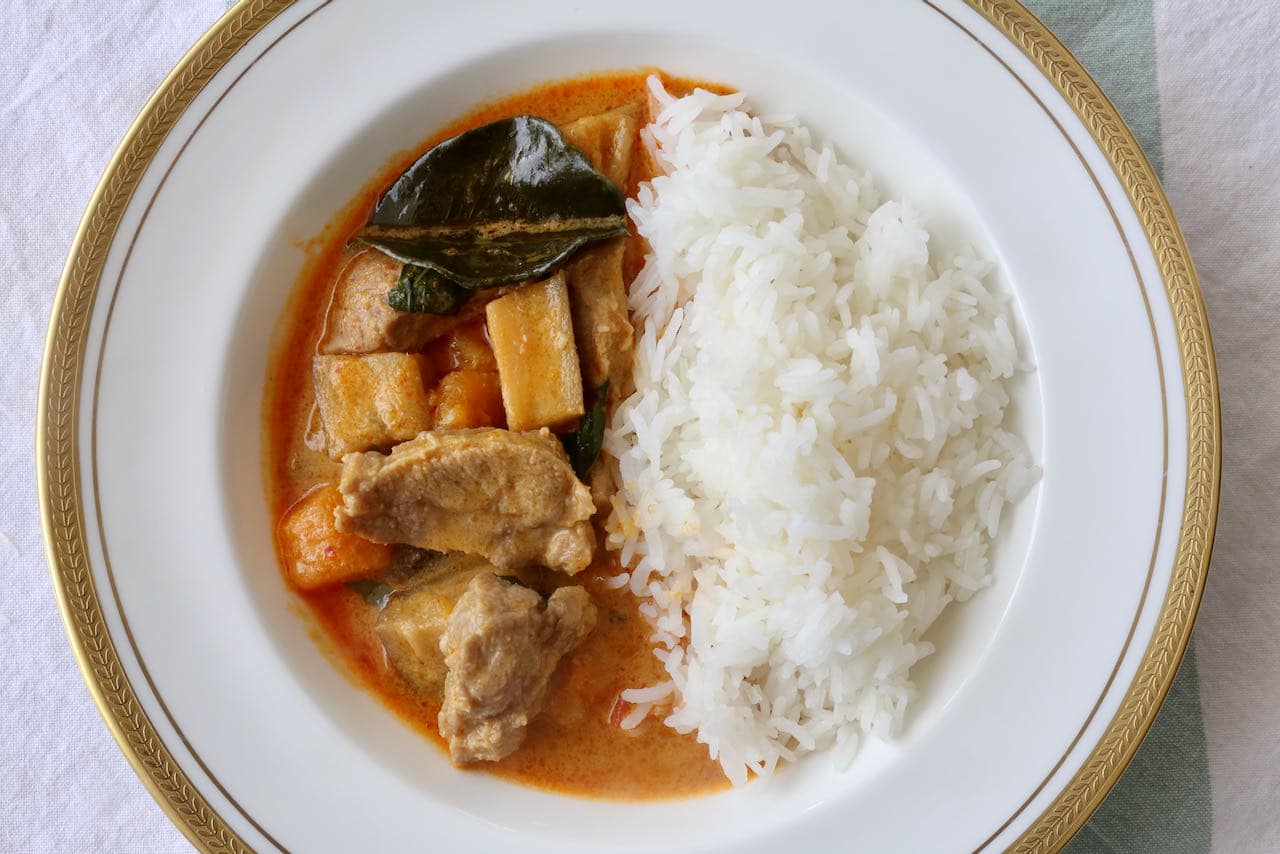
Best Red Thai Pork Curry Recipe
Thai Red Curry Pork
Equipment
- Mixing bowls
- measuring cups
- measuring spoons
- French knife
- Wooden spoon or spatula
- Wok
Ingredients
Pork Marinade
- 1 kg Pork Shoulder cut into 1 1/2 inch strips
- 6 tbsp Water
- 4 tbsp Canola oil
- 4 tsp Cornstarch
Red Curry Sauce
- 2 cup Water
- 2 tbsp Lime juice
- 2 tsp Kosher salt
- 4 Japanese Eggplants cut into 1 inch chunks
- 2 cup Coconut cream
- 1/2 cup Red curry paste
- 2 tbsp Brown sugar or Palm sugar
- 1.5 cups Butternut squash diced
- 2 cups Coconut milk mixed with 2 cups of water
- 4 Red Thai Chiles sliced, seeds removed
- 2 cup Thai basil leaves
- 12 Lime leaves thinly sliced
- 4 tbsp Fish sauce
Instructions
Pork Marinade
- In a large mixing bowl combine water, oil, cornstarch and salt. Add the sliced pork shoulder to the bowl and mix well. Cover and marinate for at least 2 hours or overnight.
Red Curry Sauce
- In a medium bowl, stir together water, lime juice and salt. Add eggplant chunks to the bowl and soak to prevent the eggplant from turning brown. Set aside. Drain and rinse before cooking.
- In a large wok over high heat, heat the coconut cream until it bubbles, 2 to 3 minutes. Add the red curry paste, brown sugar, pork, and squash and stir to mix. Reduce the heat to medium-low and simmer, stirring often, for approximately 5 minutes. Add the thin coconut milk and continue cooking, stirring for 15 minutes.
- Add the eggplant and cook, stirring constantly to fully submerge the eggplant to prevent from discolouring. Add the chiles, Thai basil leaves, lime leaves and fish sauce. Mix well and cook for another minute. Season to taste then remove from the heat.
- Serve Thai Red Pork Curry with steamed rice.
Nutrition
Some of the links in this story use affiliate links. This means that if you make a purchase through our site, Dobbernationloves will earn a small commission at no extra cost to you. Your support helps us to produce comprehensive content.
Save this story to Pinterest!
